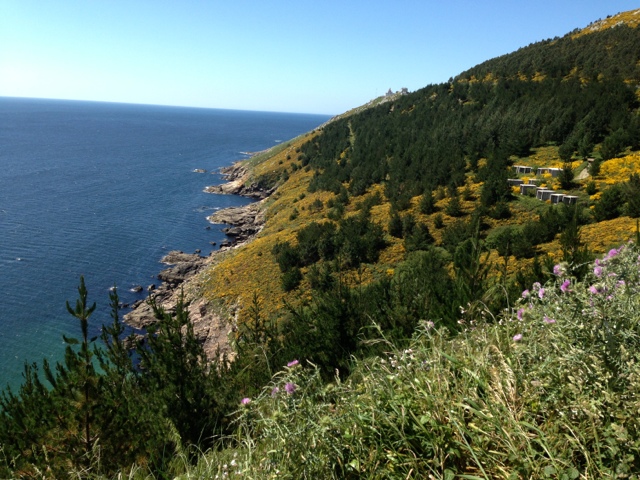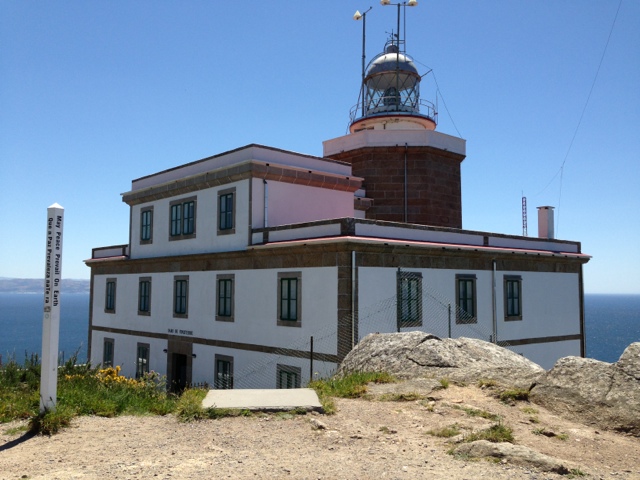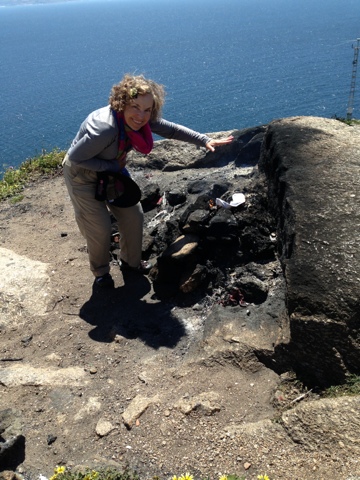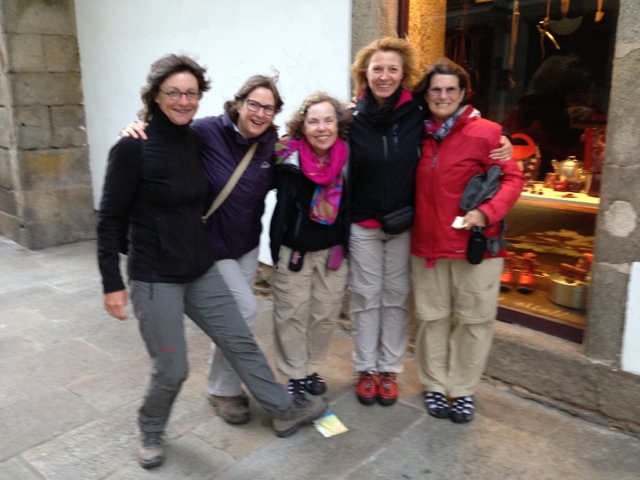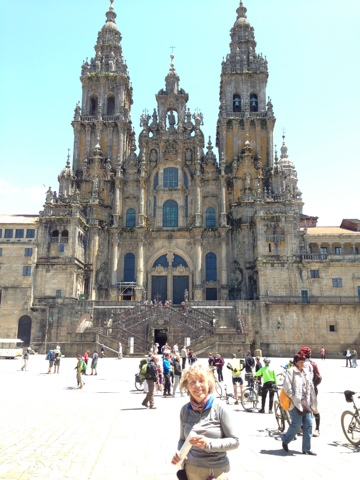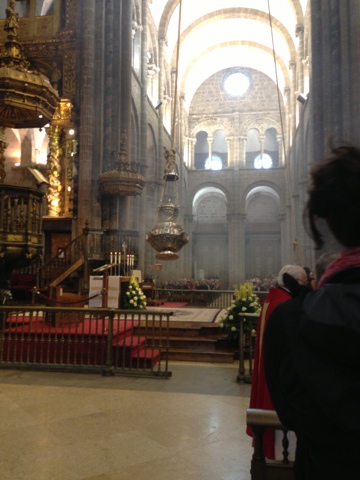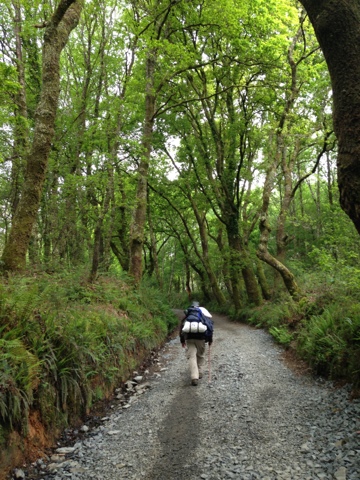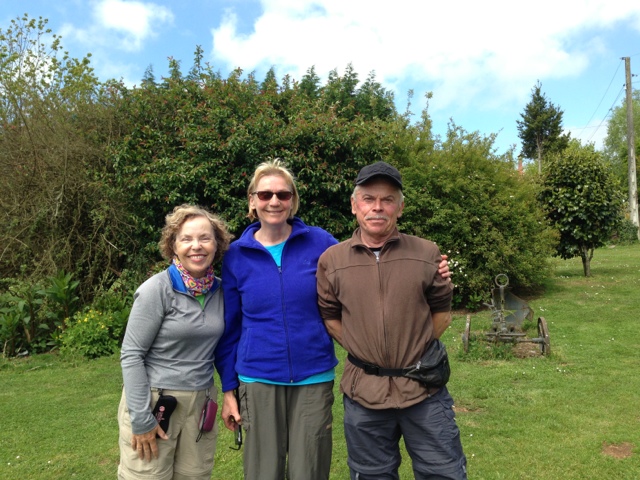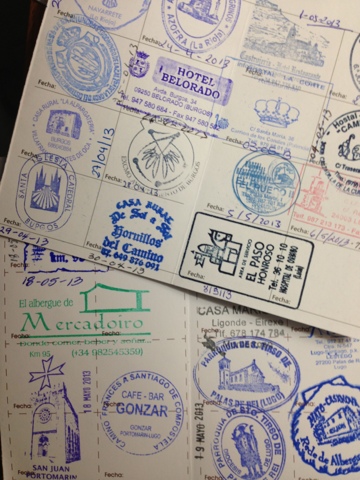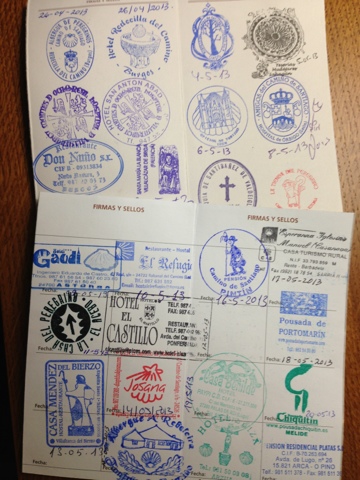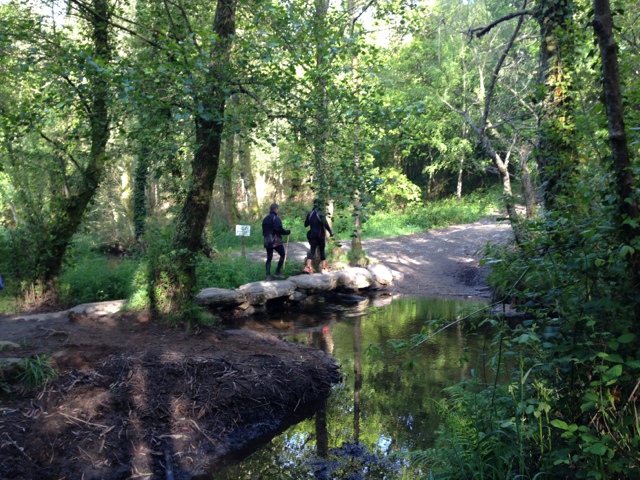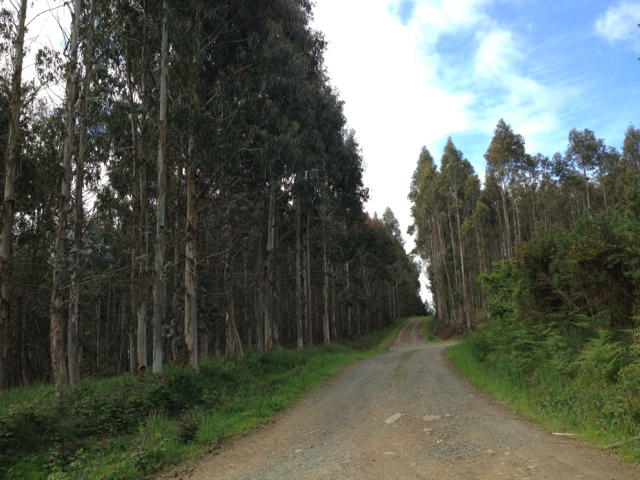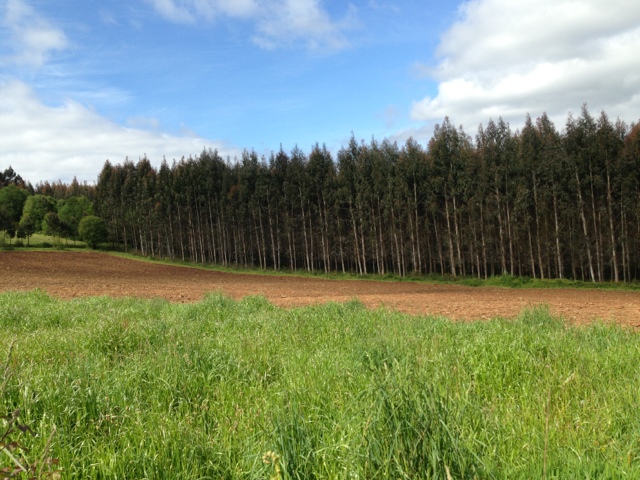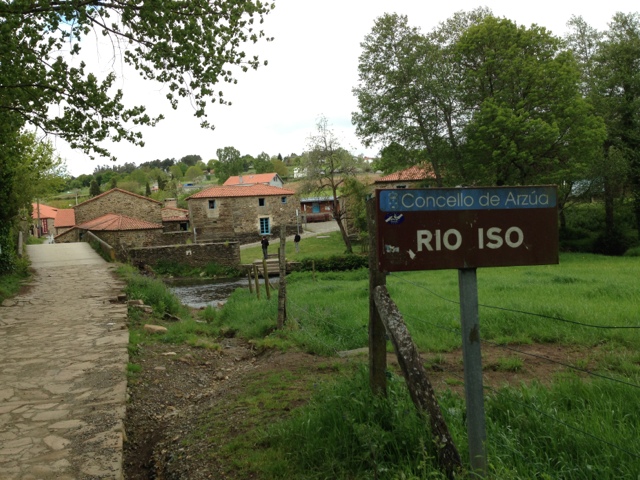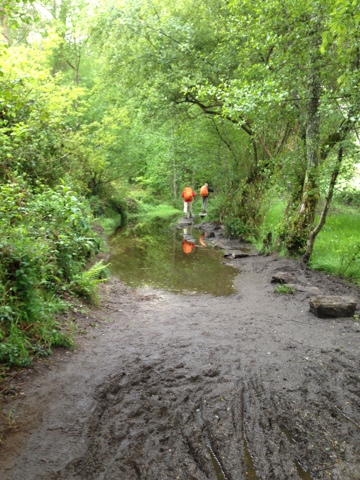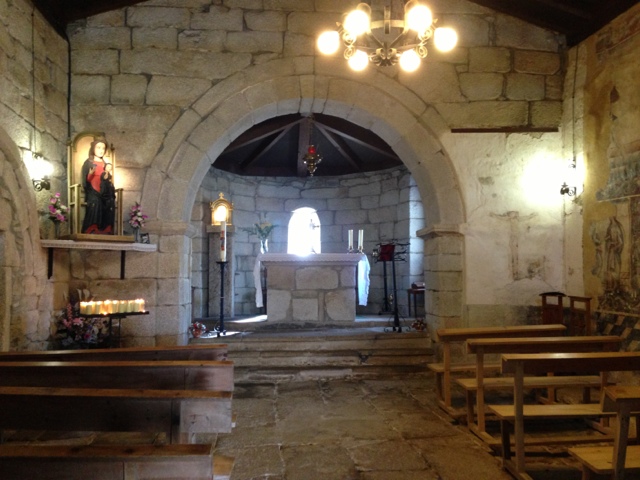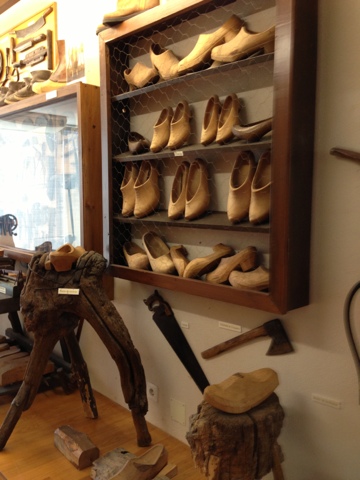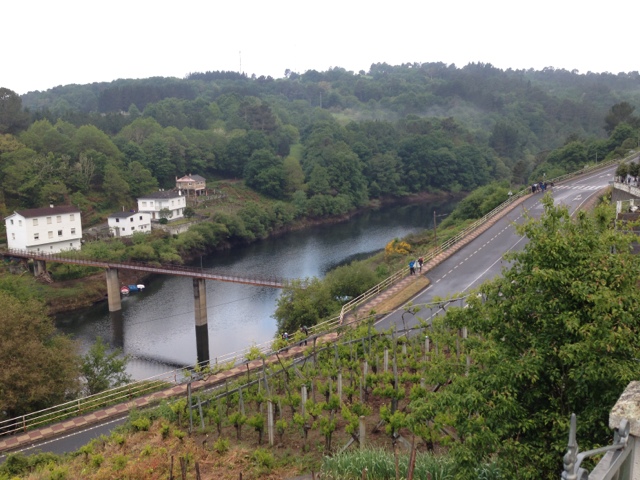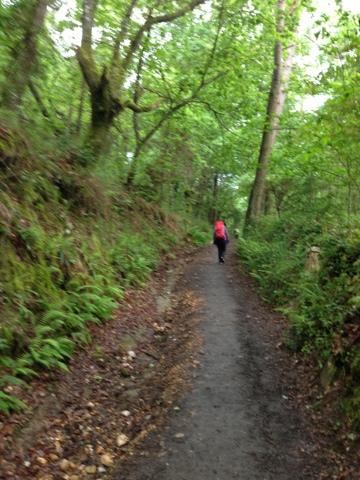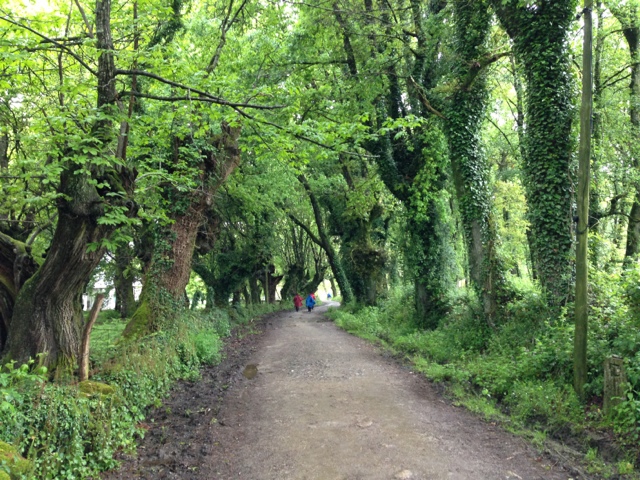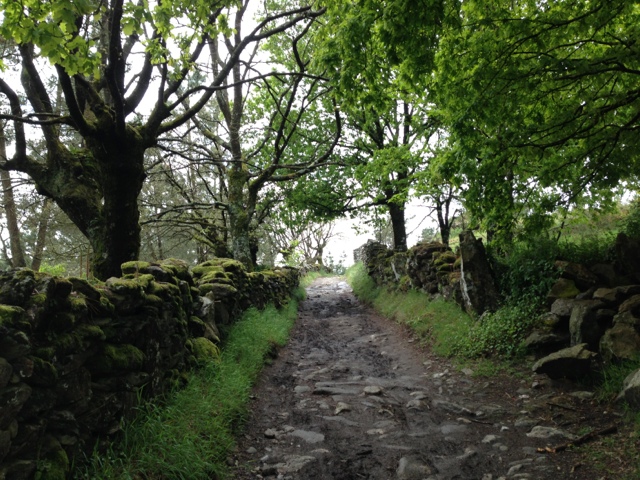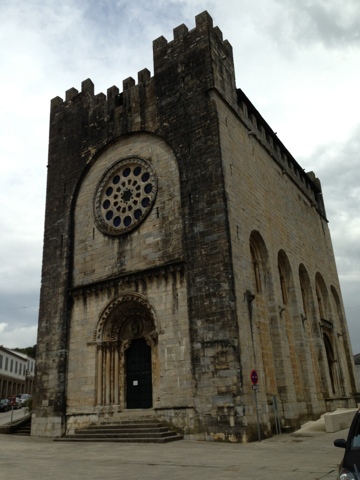(May 25) While we are in this corner of the world, we decided to visit what was considered the "end of the earth" during medieval times, Finisterre.
We tried to find a tour company, with no luck, so we opted to do it our way, with great success.
We boarded a public bus at 9 am (for 24€ RT), which was like a Grayline, and arrived in 2 hours and 20 minutes. The ride itself was quite enjoyable because, an hour into it, we were driving along inlets from the coast with quaint little villages nestled at the base of the rocky cliffs. The water was clear and calm and we were blessed with a gorgeous, sunny day.
Since it was lunchtime when we arrived, we stopped at one of the restaurants overlooking the harbor and had Sopa de Galega, which is a hot soup, usually made of potatoes, spinach, cabbage, and sometimes beans, flavored with meat such as pork or sausage.
Then we walked the 3.5 K (about 2.5 miles) to the lighthouse, which is km 0 on the way to Santiago. (Photo 1) Built in 1853, it is high on the westernmost tip of a rocky, hilly coastline, (photo 2) and provides a panoramic view of the ocean. (Photo 3)
Part of the ritual of going to Finisterre is burning your clothes. As worn as mine are now, that still didn't seem like a good idea. However, I did have a pair of bad sock liners that gave me some blisters early on that I never want to see again. They were perfect fuel for the ongoing pyre.(Photo 4)
While we were up there, we ran into friends Tony and Geraldine from Ireland and Chris and Peter from the US. Chris had been sick much of the trip but was now well and had completed the Camino.
Later we ran into another friend Christine who had connected with her boyfriend in Sarria and walked from there to Finisterre. So far all of our Camino friends seem to have happy endings.
Then we walked the other direction to the beach of A Langosteira. It was very quiet except for a bar, a few bathers, and a couple of abandoned boats. (Photos 5-8) We collected some shells and then returned to the city center to catch the return bus.
We got back at 7 after a 2 hr, 15 minute ride. Then we did some shopping and had dinner at the Derby Bar. It did have a jockey hat and whip on its logo. Afterwards we discovered a luscious park near our hotel and plan to explore that tomorrow along with several other sights we've yet to see.
Sunday, May 26, 2013
Friday, May 24, 2013
Santiago
We haven't done the final calculations, but even taking into account some "leap frogging" due to weather or injuries, we walked more than 400 miles in 5 weeks, essentially across northern Spain.
This morning we tried to sleep in but couldn't. So we looked for a coffee shop that had interested us last night, and we were 15 minutes early. We decided to wait out the time in the Cathedral, and who did we spy there but Emily, a 20-something woman from Pittsburgh whom we have been with off and on for much of the trip. We thought we would miss her so this was a wonderful surprise. She was on her way, walking to Finisterre, and we convinced her to have coffee with us. (Photo 1) We chose a delightful cafe that has been in existence since 1897.
Then we ran some errands and went back to the Cathedral to attend the noon mass for pilgrims. On our way, Michele shot this photo of me (2) with one of the many mimes that work the large plaza in front of the church. The mass was well attended, with many people standing, but they didn't have any of the pomp and circumstance (or incense) from last night. I'm so glad we had not missed that.
After mass we finally snagged a photo of the two of us in front of the Cathedral. (3) We had been so busy hugging everyone yesterday that we had not done it. This shows how massive the Cathedral is and how weathered. No sand blasting here.
After mass we continued to see people we had walked with off and on during the last few weeks.
Then we went to lunch in the garden courtyard of a hotel with friends Brent from Barcelona (formerly California), Mike from Florida, Mike from Tahoe, Rene from Reno, and another woman from Nashville. Turns out the woman from Nashville and I knew a lot of the same people since I had lived there 4 years. Continues to be a small world.
This evening we went to dinner again with our Dutch friends Perry, Gerrie, and Sabina at the same place we had breakfast. Dinner was equally delightful and I had the paella as did others. We walked them back to their hotel and said some tearful goodbyes. On the way we ran into some other friends and had our photo taken with the girls.(4, L to R: Sabina, Gerrie, me, Angelica, Michele) Our friends told us about their trip to Finisterre today, our destination for tomorrow -- the place that was once the "end of the known world" before Christopher Columbus and others.
This morning we tried to sleep in but couldn't. So we looked for a coffee shop that had interested us last night, and we were 15 minutes early. We decided to wait out the time in the Cathedral, and who did we spy there but Emily, a 20-something woman from Pittsburgh whom we have been with off and on for much of the trip. We thought we would miss her so this was a wonderful surprise. She was on her way, walking to Finisterre, and we convinced her to have coffee with us. (Photo 1) We chose a delightful cafe that has been in existence since 1897.
Then we ran some errands and went back to the Cathedral to attend the noon mass for pilgrims. On our way, Michele shot this photo of me (2) with one of the many mimes that work the large plaza in front of the church. The mass was well attended, with many people standing, but they didn't have any of the pomp and circumstance (or incense) from last night. I'm so glad we had not missed that.
After mass we finally snagged a photo of the two of us in front of the Cathedral. (3) We had been so busy hugging everyone yesterday that we had not done it. This shows how massive the Cathedral is and how weathered. No sand blasting here.
After mass we continued to see people we had walked with off and on during the last few weeks.
Then we went to lunch in the garden courtyard of a hotel with friends Brent from Barcelona (formerly California), Mike from Florida, Mike from Tahoe, Rene from Reno, and another woman from Nashville. Turns out the woman from Nashville and I knew a lot of the same people since I had lived there 4 years. Continues to be a small world.
This evening we went to dinner again with our Dutch friends Perry, Gerrie, and Sabina at the same place we had breakfast. Dinner was equally delightful and I had the paella as did others. We walked them back to their hotel and said some tearful goodbyes. On the way we ran into some other friends and had our photo taken with the girls.(4, L to R: Sabina, Gerrie, me, Angelica, Michele) Our friends told us about their trip to Finisterre today, our destination for tomorrow -- the place that was once the "end of the known world" before Christopher Columbus and others.
Arca to Santiago
(May 23) Our last day of walking! Our anticipation got us up early and we met Perry for a quick breakfast before we started the last 14 miles of our journey.
We were surprised to find we were still on a beautiful wooded trail (photo 1) even though we were headed for an area around the Santiago airport. We stopped only once for coffee where I had an incredible apple tart.
Perry started with a count-down similar to New Year's Eve as we crossed off the kilometers on the stone markers along the way.
Just about 4 miles from the city, we reached Monte del Gozo, which is a 1200 ft. high peak overlooking the city. There is a monument commemorating the visit of Pope John Paul II. (Photo 2,3)
For about two-thirds of the walk, we were on paths and small roads until we reached the outskirts of the city. Then we had to maneuver ourselves through the suburbs and modern city streets on pavement and sidewalks until we reached the historic section of town. Then the excitement began to build. We passed several old historic buildings and mistook the tower of one of them as a first sighting of the Cathedral.
But we continued on, ultimately going through the Arch of the Pazo do Xelmirez, holding on to one another with Perry in the middle, and there it was in all its splendor: the Cathedral of Santiago, our final destination. After all this time, the feeling of euphoria was overwhelming and actually brought tears to my eyes. We saw other pilgrims we knew and started to hug and congratulate one another. Others whose names we did not know, but whom we had seen on the trail over the past several weeks, joined in the celebration. (Photo 4 is me in front of the Cathedral, looking quite bedraggled in the wind.)
Afterwards, we went to the Pilgrim Credential office where we showed our passport stamps and were given an official Compostela, certifying that we had walked the Camino.
Exhausted, we checked into our lodging, Hostal Mapoula, a few blocks from the Cathedral and only 50€ for a spacious room and bath. This will be our home for the next 4 days.
Later Michele, Perry and I met our Dutch friends Sabina and Gerrie for a light dinner. The 5 of us have become good friends and have been together off and on for 3-4 weeks. The two women told us we have a special place in their hearts and wanted to give us something but only had two left for the three of us so Michele and I would have to share. It was a tiny pair of blue and white ceramic Dutch clogs tied with a red, white and blue ribbon, their flag's colors. They said we would each get one shoe. Actually, I rather like that because it also joins me and Michele -- I'll always know the mate to that shoe is with her. Then Gerrie reminded me that I had given her an extra pair of gloves I had when we were going into the mountains and she had not brought any. They said they were each going to keep one glove as a remembrance of our friendship.
Now it was 7 pm and we went to a high mass at the Cathedral in honor of a special feast day. (Photo 5-interior) It was like a theatrical performance, starting with a processional around the interior, complete with musical instruments. Then they filled a giant incense burner, a botafumeiro, and began swinging it from an elaborated pulley system high up in the ceiling. It took 4 men to pull on the ropes and control its movement. We sat on the side so it swung right over us. (Photo 6,7)
Next we were treated to lovely organ music and an awesome choir. Even the priest had a great voice. The service was all in Spanish but was so beautifully done that it was totally enjoyable. Afterwards, more drinks with friends and off to bed, our journey at an end.
We were surprised to find we were still on a beautiful wooded trail (photo 1) even though we were headed for an area around the Santiago airport. We stopped only once for coffee where I had an incredible apple tart.
Perry started with a count-down similar to New Year's Eve as we crossed off the kilometers on the stone markers along the way.
Just about 4 miles from the city, we reached Monte del Gozo, which is a 1200 ft. high peak overlooking the city. There is a monument commemorating the visit of Pope John Paul II. (Photo 2,3)
For about two-thirds of the walk, we were on paths and small roads until we reached the outskirts of the city. Then we had to maneuver ourselves through the suburbs and modern city streets on pavement and sidewalks until we reached the historic section of town. Then the excitement began to build. We passed several old historic buildings and mistook the tower of one of them as a first sighting of the Cathedral.
But we continued on, ultimately going through the Arch of the Pazo do Xelmirez, holding on to one another with Perry in the middle, and there it was in all its splendor: the Cathedral of Santiago, our final destination. After all this time, the feeling of euphoria was overwhelming and actually brought tears to my eyes. We saw other pilgrims we knew and started to hug and congratulate one another. Others whose names we did not know, but whom we had seen on the trail over the past several weeks, joined in the celebration. (Photo 4 is me in front of the Cathedral, looking quite bedraggled in the wind.)
Afterwards, we went to the Pilgrim Credential office where we showed our passport stamps and were given an official Compostela, certifying that we had walked the Camino.
Exhausted, we checked into our lodging, Hostal Mapoula, a few blocks from the Cathedral and only 50€ for a spacious room and bath. This will be our home for the next 4 days.
Later Michele, Perry and I met our Dutch friends Sabina and Gerrie for a light dinner. The 5 of us have become good friends and have been together off and on for 3-4 weeks. The two women told us we have a special place in their hearts and wanted to give us something but only had two left for the three of us so Michele and I would have to share. It was a tiny pair of blue and white ceramic Dutch clogs tied with a red, white and blue ribbon, their flag's colors. They said we would each get one shoe. Actually, I rather like that because it also joins me and Michele -- I'll always know the mate to that shoe is with her. Then Gerrie reminded me that I had given her an extra pair of gloves I had when we were going into the mountains and she had not brought any. They said they were each going to keep one glove as a remembrance of our friendship.
Now it was 7 pm and we went to a high mass at the Cathedral in honor of a special feast day. (Photo 5-interior) It was like a theatrical performance, starting with a processional around the interior, complete with musical instruments. Then they filled a giant incense burner, a botafumeiro, and began swinging it from an elaborated pulley system high up in the ceiling. It took 4 men to pull on the ropes and control its movement. We sat on the side so it swung right over us. (Photo 6,7)
Next we were treated to lovely organ music and an awesome choir. Even the priest had a great voice. The service was all in Spanish but was so beautifully done that it was totally enjoyable. Afterwards, more drinks with friends and off to bed, our journey at an end.
Wednesday, May 22, 2013
Arzua to Arca
(May 22, 2013) It is the day before I reach Santiago and the anticipation is beginning to mount. I can see why some people want to do longer days now and hurry it up - like a child wanting Christmas to come early. My friend Perry compares it to the excitement of New Year's Eve. I agreed, but said it is because we will now start to look back on our journey, the way we do with a passing year, and then look ahead to what will come after. Hopefully, our experience has brought us new insight into ourselves and the world around us and we will all return home refreshed and renewed.
When we have traveled through many of these old villages, they have often talked of the old pilgrim hospitals, which no longer exist. I can't help but imagine what this journey was like 1,000 years ago without proper footwear and gear, no place to buy food and exposure to criminals and disease. It must have been extremely arduous and people must have suffered greatly. It does give you an appreciation for our current lives.
But just watching the people work in their fields today is impressive, too. I saw a man cutting weeds along the road with a scythe and then piling them up with a fork made from a tree branch. It looked well worn. Another man was disassembling an old stone building rock by rock and cleaning each one of debris as he went. He carefully stacked them on the scaffolding for future use.(photos 1, 2) I'm afraid we in the US would just bulldoze it and throw it in a landfill.
Much of the path was as beautiful as yesterday, with the tall trees forming a canopy over the trail (photo 3). I learned that the ubiquitous eucalyptus trees are not indigenous but were brought in for the pulp business.
But the tree that impressed me today were these palm trees. How do you grow those in a climate like Kentucky's? (Photo 4)
I met up with Michele and Perry and we walked most of the way together. At one of our stops I saw my German friends Bridgit and Peter who have the relative in Louisville. I want to look up the relative and show him this photo (#5).
We arrived in Arca about 2:30 after about 13 miles and several stops. It was a gorgeous day and we wanted to enjoy it. We checked into Hostal Platas, which turned out to be very nice for 55€.
Tonight Perry, Michele and I had a very simple dinner and talked about our day tomorrow. We will not arrive until early afternoon but will probably attend an evening mass.
We will also go to the Pilgrim's Office to show them our pilgrim passports in order to receive our certificate of completion, our Compostela. I forgot to mention earlier about the passports. All along the way we collect "sellos" or stamps from the hotels, bars, churches, etc., to prove we were there. I made one just for my lodging so I could document each day. Then I have 2 others with random stamps from the trip. (Photos 6,7) They are fun to collect. For me, the small booklets will be a great memento of the trip.
When we have traveled through many of these old villages, they have often talked of the old pilgrim hospitals, which no longer exist. I can't help but imagine what this journey was like 1,000 years ago without proper footwear and gear, no place to buy food and exposure to criminals and disease. It must have been extremely arduous and people must have suffered greatly. It does give you an appreciation for our current lives.
But just watching the people work in their fields today is impressive, too. I saw a man cutting weeds along the road with a scythe and then piling them up with a fork made from a tree branch. It looked well worn. Another man was disassembling an old stone building rock by rock and cleaning each one of debris as he went. He carefully stacked them on the scaffolding for future use.(photos 1, 2) I'm afraid we in the US would just bulldoze it and throw it in a landfill.
Much of the path was as beautiful as yesterday, with the tall trees forming a canopy over the trail (photo 3). I learned that the ubiquitous eucalyptus trees are not indigenous but were brought in for the pulp business.
But the tree that impressed me today were these palm trees. How do you grow those in a climate like Kentucky's? (Photo 4)
I met up with Michele and Perry and we walked most of the way together. At one of our stops I saw my German friends Bridgit and Peter who have the relative in Louisville. I want to look up the relative and show him this photo (#5).
We arrived in Arca about 2:30 after about 13 miles and several stops. It was a gorgeous day and we wanted to enjoy it. We checked into Hostal Platas, which turned out to be very nice for 55€.
Tonight Perry, Michele and I had a very simple dinner and talked about our day tomorrow. We will not arrive until early afternoon but will probably attend an evening mass.
We will also go to the Pilgrim's Office to show them our pilgrim passports in order to receive our certificate of completion, our Compostela. I forgot to mention earlier about the passports. All along the way we collect "sellos" or stamps from the hotels, bars, churches, etc., to prove we were there. I made one just for my lodging so I could document each day. Then I have 2 others with random stamps from the trip. (Photos 6,7) They are fun to collect. For me, the small booklets will be a great memento of the trip.
Melides to Arzua
(May 21) I love how Europeans (and most everyone else besides Americans) use kilometers to measure distance instead of miles. It makes our daily distance sound more impressive when measured that way. For instance, I walked 16 kilometers today but it really was only 10 miles (16 divided by 1.6). A relatively short day, but tomorrow will make up for it.
Today continued with much the same scenery we have experienced ever since we entered Galicia - farmlands, rolling hills and deciduous forests. At least the rain has stopped, but there is still a lot of cloudiness.
Leaving Melide, I walked past Saint Mary's Romanesque Church 12th C) (photo 1) and back into the woods. (Photo 2). The primary tree I saw today are the tall eucalyptus that have been planted between fields and along the pathways, like sentries guarding the way.(photo 3, 4)
I passed through only a few villages, and most just had an albergue and a bar and a few deteriorating old structures. I liked this one scene as I left Casteneda (photo 5) because it is so typical of the region-- stone cross, stone fountain, stone house.
An attractive exception was Ribadiso, located on the River Iso (photo 6) with its medieval bridge, and many stone buildings which have been restored.
My final destination for today was Arzua. (Pop. 7,000) where I checked into the Hotel Suiza for 36€. Not as nice or as convenient as I would have expected.
There is very little of an old world feel to this city, with the exception of a small central plaza on the main street where several outdoor cafes are located. Michele and I met our dear friend Perry from Holland whom we had not seen since Leon. We had dinner together and shared our thoughts about the upcoming end of our journey. We plan to be in Santiago on Thursday!
Today continued with much the same scenery we have experienced ever since we entered Galicia - farmlands, rolling hills and deciduous forests. At least the rain has stopped, but there is still a lot of cloudiness.
Leaving Melide, I walked past Saint Mary's Romanesque Church 12th C) (photo 1) and back into the woods. (Photo 2). The primary tree I saw today are the tall eucalyptus that have been planted between fields and along the pathways, like sentries guarding the way.(photo 3, 4)
I passed through only a few villages, and most just had an albergue and a bar and a few deteriorating old structures. I liked this one scene as I left Casteneda (photo 5) because it is so typical of the region-- stone cross, stone fountain, stone house.
An attractive exception was Ribadiso, located on the River Iso (photo 6) with its medieval bridge, and many stone buildings which have been restored.
My final destination for today was Arzua. (Pop. 7,000) where I checked into the Hotel Suiza for 36€. Not as nice or as convenient as I would have expected.
There is very little of an old world feel to this city, with the exception of a small central plaza on the main street where several outdoor cafes are located. Michele and I met our dear friend Perry from Holland whom we had not seen since Leon. We had dinner together and shared our thoughts about the upcoming end of our journey. We plan to be in Santiago on Thursday!
Monday, May 20, 2013
Palas de Rei to Melides
It is 10 pm and the sun is still setting over Melide, a beautiful little town of 7,000 in the middle of the autonomous province of Galicia.
Sun was the blessing for the day after what seemed liked days of rain and cold weather. The trail started out muddy (photo 1), but soon turned into a rather firm country path interspersed with country road. Again we were walking through deciduous forests, but with a preponderance of oak trees and eucalyptus trees, the latter with their elongated leaves, shedding bark and distinctive aroma.
I am still fascinated by the farm culture of this area. Today I photographed a cabaceiro, a circular twine structure with a thatch roof, which was also used to store grain and vegetables (usually corn). (Photo 2) This was is seen in front of the 13th C Romanesque Church of Santa Maria do Leboreiro. I know 4I have lots of photos of the insides of churches, but this one was beautiful in its austerity. (Photo 3)
Shortly afterwards I passed over the medieval Magdalena Bridge over the Rio Seco and was joined by a group of lively Spanish young people. One wanted to pretend he was going to jump off the bridge. (Photo 4)
Another medieval bridge (photos 5, 6) the Ponte Velha, took me into Furelos, a traditional village.
Soon after I reached Melides, my destination for the day at only 10 miles. I checked into the Pousada Chiquitin at 30€ for the night. After a brief rest, I explored the city. There was an interesting museum that had artifacts of the history of the area. Apparently, there is an archeological dig not too far away and they found a number of Roman coins from 200 AD. They also showcased traditional crafts such as lace making (photo 7) and shoe making (photo 8). I guess when you have a lot of mud, those thick wooden clog style shoes work very well.
Then I walked along the main street where there were a number of cafes across from the city park. I ran into a German couple, about my age,
Bridget and Peter from the Black Forest area. We have been hiking together off and on since Villafranca del Bierzo and seem to have a similar pace. We ended up having drinks and dinner together and they spoke English well. They told me they have a cousin in Louisville, a priest named Father Joe Voor, at Edenside(?) who visits them every summer. It really is a small world. My treat for dinner was pulpo (octopus) grilled and served over rice as an appetizer. Very tender. That was followed by beef stew, which is always a favorite. Included was flan and a 1/2 bottle of wine for 9€. Pretty amazing.
Sun was the blessing for the day after what seemed liked days of rain and cold weather. The trail started out muddy (photo 1), but soon turned into a rather firm country path interspersed with country road. Again we were walking through deciduous forests, but with a preponderance of oak trees and eucalyptus trees, the latter with their elongated leaves, shedding bark and distinctive aroma.
I am still fascinated by the farm culture of this area. Today I photographed a cabaceiro, a circular twine structure with a thatch roof, which was also used to store grain and vegetables (usually corn). (Photo 2) This was is seen in front of the 13th C Romanesque Church of Santa Maria do Leboreiro. I know 4I have lots of photos of the insides of churches, but this one was beautiful in its austerity. (Photo 3)
Shortly afterwards I passed over the medieval Magdalena Bridge over the Rio Seco and was joined by a group of lively Spanish young people. One wanted to pretend he was going to jump off the bridge. (Photo 4)
Another medieval bridge (photos 5, 6) the Ponte Velha, took me into Furelos, a traditional village.
Soon after I reached Melides, my destination for the day at only 10 miles. I checked into the Pousada Chiquitin at 30€ for the night. After a brief rest, I explored the city. There was an interesting museum that had artifacts of the history of the area. Apparently, there is an archeological dig not too far away and they found a number of Roman coins from 200 AD. They also showcased traditional crafts such as lace making (photo 7) and shoe making (photo 8). I guess when you have a lot of mud, those thick wooden clog style shoes work very well.
Then I walked along the main street where there were a number of cafes across from the city park. I ran into a German couple, about my age,
Bridget and Peter from the Black Forest area. We have been hiking together off and on since Villafranca del Bierzo and seem to have a similar pace. We ended up having drinks and dinner together and they spoke English well. They told me they have a cousin in Louisville, a priest named Father Joe Voor, at Edenside(?) who visits them every summer. It really is a small world. My treat for dinner was pulpo (octopus) grilled and served over rice as an appetizer. Very tender. That was followed by beef stew, which is always a favorite. Included was flan and a 1/2 bottle of wine for 9€. Pretty amazing.
Sunday, May 19, 2013
Portomarin to Palas de Rei
When I left Portomarin about 8:30 this morning, I felt like I had finally encountered "the wave." Pilgrims of all ages (many young people now with school out) were pouring out of the albergues and on to the Camino. The path out of town led back to the reservoir and over the River Mino.(photo 1). The descent is very similar to what is experienced around Madison, IN, to the Ohio River.
Again, today, the trail looked very much like West Virginia and Kentucky. (Photo 2)
We continued to travel through farmlands and encountered the occasional herd of cattle being led from the barn, which is often near the house, to the pasture down the street (photo 3).
The first bar I stopped at was in Gonzar and it was like a reunion. People I had not seen in days were there -- the couple from Nashville, Karin from yesterday's breakfast, the older Austrian couple I have followed for 5 days, and a Spanish woman, my age, whom I have hiked with off and on but whom I haven't seen for several days. Gerrie and Sabina were there, too, and we had coffee together.
Afterwards, we had this long climb up a paved path and Gerrie caught this photo of me making it to the top. (Photo 4)
Galicia is farm country and most of our scenery is related. One thing that had caught my eye are these little "houses" that seem to be at every farm. Some are very simple; some elaborate. Some in good shape and some in disrepair. Some even have religious symbols at both ends. (Photos 5, 6, 7) I asked about them and discovered this information.
They are called "horreos." They are raised from the ground on pillars or a stone base. Their purpose is to keep grains, vegetables and fruits dry and away from rodents and other plagues. They were also built with ventilation. The old ones have wood slats but the newer ones use bricks turned sideways. Today with new agricultural techniques, very few are still used but for some they make a great place to store firewood. What surprised me the most was that all of them seemed to have the exact same dimension -- that someone had designed it centuries ago and everyone used the same blueprint.
Some of the farms appear to be struggling, but many of them are quite charming. I thought this one (photo 8) seemed to have it all: lovely house with chickens in the yard and laundry on the line - a very pastoral setting.
Fortunately, we didn't have rain today, although the temperature changed every 5 minutes: jacket on, jacket off, then on again. The terrain was very gradual and I made good time. I did over 15 miles in 7 hours with an hour lunch break and 2 coffee stops.
I arrived in Palas de Rei, my destination, around 3:30 and checked into the Hotel Benilde. A lovely single for 36€. Michele was up the street at an albuergue and I met her there for dinner. We were joined by a friend Martin from Denmark. Then Michele and I met Brent, our friend from several cities back, at a hotel for drinks. Afterwards, it was still daylight, and I caught a shot of the ancient Romanesque Church of San Tirso with the camellia bush and rhododendron in bloom, again, just like home. (Photo 9)
Again, today, the trail looked very much like West Virginia and Kentucky. (Photo 2)
We continued to travel through farmlands and encountered the occasional herd of cattle being led from the barn, which is often near the house, to the pasture down the street (photo 3).
The first bar I stopped at was in Gonzar and it was like a reunion. People I had not seen in days were there -- the couple from Nashville, Karin from yesterday's breakfast, the older Austrian couple I have followed for 5 days, and a Spanish woman, my age, whom I have hiked with off and on but whom I haven't seen for several days. Gerrie and Sabina were there, too, and we had coffee together.
Afterwards, we had this long climb up a paved path and Gerrie caught this photo of me making it to the top. (Photo 4)
Galicia is farm country and most of our scenery is related. One thing that had caught my eye are these little "houses" that seem to be at every farm. Some are very simple; some elaborate. Some in good shape and some in disrepair. Some even have religious symbols at both ends. (Photos 5, 6, 7) I asked about them and discovered this information.
They are called "horreos." They are raised from the ground on pillars or a stone base. Their purpose is to keep grains, vegetables and fruits dry and away from rodents and other plagues. They were also built with ventilation. The old ones have wood slats but the newer ones use bricks turned sideways. Today with new agricultural techniques, very few are still used but for some they make a great place to store firewood. What surprised me the most was that all of them seemed to have the exact same dimension -- that someone had designed it centuries ago and everyone used the same blueprint.
Some of the farms appear to be struggling, but many of them are quite charming. I thought this one (photo 8) seemed to have it all: lovely house with chickens in the yard and laundry on the line - a very pastoral setting.
Fortunately, we didn't have rain today, although the temperature changed every 5 minutes: jacket on, jacket off, then on again. The terrain was very gradual and I made good time. I did over 15 miles in 7 hours with an hour lunch break and 2 coffee stops.
I arrived in Palas de Rei, my destination, around 3:30 and checked into the Hotel Benilde. A lovely single for 36€. Michele was up the street at an albuergue and I met her there for dinner. We were joined by a friend Martin from Denmark. Then Michele and I met Brent, our friend from several cities back, at a hotel for drinks. Afterwards, it was still daylight, and I caught a shot of the ancient Romanesque Church of San Tirso with the camellia bush and rhododendron in bloom, again, just like home. (Photo 9)
Rente (Sarria) to Portomarin
This morning I was all set to have breakfast and leave shortly after 8. However, when I went downstairs in the farm house, it was very dark and the doors were locked. Equally important was that my shoes and raincoat, which I had dutifully left by the front door to keep the place clean, were nowhere to be found. And I still had not paid, a strange custom where one doesn't pay until after the service is rendered.
Finally, I found an elderly man in the kitchen who then went and woke the mistress of the manor. She didn't seem too pleased even though it was 8 and I had said last night I was leaving at 8. I asked her about my things and she went outside in a shed to get them. Strange place to put things considering it never stopped raining last night. They were ok but cold.
Then she insisted I sit down to have breakfast -- which is nothing more than cafe con leche and toast, but gets you started. While I was waiting, a woman named Karin from Holland whom I had met yesterday in a coffee shop, arrived from an albuergue down the road, and we ate together. I am always impressed at how well the Dutch speak English. She told me her Camino story, a sad one. She is about 50 and had recently lost her husband. She was doing the Camino to put some distance between her home and sad thoughts of him to focusing on the potential of her future life. We also spoke of adult daughters (she has 2) and relationships. We hugged and said we would meet again on the Camino.
Finally, my hostess came in with the bill: 48€ for my room, dinner and breakfast. An incredible deal.
So at 9, I ventured out into the rain. There were a number of pilgrims who had started in Sarria (about 3 miles back), who were now passing by. I joined the parade.
The scenery today was very similar to yesterday -- deciduous forests with moss- laden tree trunks (photo 1) interrupted by farmlands where cows and sheep graze. (Photo 2) Where you have constant rain and country trails, sooner or later you are going to get mud -- and we had plenty of it today. Sometimes these trails, as well as the rough streets in the villages, are used to move cows from one pasture to another. That makes for an interesting mix on the trail -- is that mud or is it ...? After awhile, you realize you can't dodge it all and you just plow through.
For awhile today I walked with a charming 20-something man from Ireland. We had a nice chat about the Camino and his girlfriend. She was supposed to have joined him in Sarria, but he got there too soon. He is a fast walker. So she will meet him in Santiago and walk to Finistere with him instead. He said the Irish don't like to take vacations to sit on the beach -- they want to be active. I said I can relate to that.
There were several pilgrim fountains today but this one was different -- it seems to have a representation of Joan Miro's artwork. (Photo 3)
The landscape continues to resemble Kentucky, including the stone fences (photo 4) and the shaded paths (photo 5).
I finally reached Portomarin, my destination for the day, after about 10 miles. This town sits on a large reservoir which is known as the Embalse de Belesar. Formerly this was the Mino River and was damed up in the 60's. This area is a natural basin because we had to walk down a steep incline to the new bridge and then up to reach the city. Greeting us at the end of the bridge was a steep staircase that was part of the original medieval bridge. (Photo 6 and 7)These led up to the arch and Capela de Santa Maria de las Nieves which, along with several other historic monuments, were all removed to high ground when the dam was built to create the reservoir in 1962. Included in this was the austere Romanesque church of San Nicholas (12th C), also known as San Juan due to its links to the Knights of St. John who guarded this part of the Camino. It was painstakingly rebuilt on the city square (photo 8) from its original site now submerged under the reservoir.
I checked in at the Pousada de Portomarin, a bit of a splurge tonight at 68€. However, exchanged into $, that's about $88, what I pay at the Super 8 in Huntington, WV.
Later I had dinner with Sabina and Gerrie, two women from Holland with whom I have shared several meals over the past few weeks. We seem to be on a similar schedule. I always enjoy their company and we talk on a wide range of topics.
Finally, I found an elderly man in the kitchen who then went and woke the mistress of the manor. She didn't seem too pleased even though it was 8 and I had said last night I was leaving at 8. I asked her about my things and she went outside in a shed to get them. Strange place to put things considering it never stopped raining last night. They were ok but cold.
Then she insisted I sit down to have breakfast -- which is nothing more than cafe con leche and toast, but gets you started. While I was waiting, a woman named Karin from Holland whom I had met yesterday in a coffee shop, arrived from an albuergue down the road, and we ate together. I am always impressed at how well the Dutch speak English. She told me her Camino story, a sad one. She is about 50 and had recently lost her husband. She was doing the Camino to put some distance between her home and sad thoughts of him to focusing on the potential of her future life. We also spoke of adult daughters (she has 2) and relationships. We hugged and said we would meet again on the Camino.
Finally, my hostess came in with the bill: 48€ for my room, dinner and breakfast. An incredible deal.
So at 9, I ventured out into the rain. There were a number of pilgrims who had started in Sarria (about 3 miles back), who were now passing by. I joined the parade.
The scenery today was very similar to yesterday -- deciduous forests with moss- laden tree trunks (photo 1) interrupted by farmlands where cows and sheep graze. (Photo 2) Where you have constant rain and country trails, sooner or later you are going to get mud -- and we had plenty of it today. Sometimes these trails, as well as the rough streets in the villages, are used to move cows from one pasture to another. That makes for an interesting mix on the trail -- is that mud or is it ...? After awhile, you realize you can't dodge it all and you just plow through.
For awhile today I walked with a charming 20-something man from Ireland. We had a nice chat about the Camino and his girlfriend. She was supposed to have joined him in Sarria, but he got there too soon. He is a fast walker. So she will meet him in Santiago and walk to Finistere with him instead. He said the Irish don't like to take vacations to sit on the beach -- they want to be active. I said I can relate to that.
There were several pilgrim fountains today but this one was different -- it seems to have a representation of Joan Miro's artwork. (Photo 3)
The landscape continues to resemble Kentucky, including the stone fences (photo 4) and the shaded paths (photo 5).
I finally reached Portomarin, my destination for the day, after about 10 miles. This town sits on a large reservoir which is known as the Embalse de Belesar. Formerly this was the Mino River and was damed up in the 60's. This area is a natural basin because we had to walk down a steep incline to the new bridge and then up to reach the city. Greeting us at the end of the bridge was a steep staircase that was part of the original medieval bridge. (Photo 6 and 7)These led up to the arch and Capela de Santa Maria de las Nieves which, along with several other historic monuments, were all removed to high ground when the dam was built to create the reservoir in 1962. Included in this was the austere Romanesque church of San Nicholas (12th C), also known as San Juan due to its links to the Knights of St. John who guarded this part of the Camino. It was painstakingly rebuilt on the city square (photo 8) from its original site now submerged under the reservoir.
I checked in at the Pousada de Portomarin, a bit of a splurge tonight at 68€. However, exchanged into $, that's about $88, what I pay at the Super 8 in Huntington, WV.
Later I had dinner with Sabina and Gerrie, two women from Holland with whom I have shared several meals over the past few weeks. We seem to be on a similar schedule. I always enjoy their company and we talk on a wide range of topics.
Subscribe to:
Posts (Atom)

